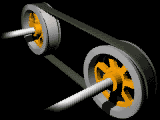Power transmission belts have been present for over 150 years. These belts have become a vital commodity in carrying out necessary industrial tasks. Compared to chain drives or rope drives, belt drives are more significant, especially on the industrial level. For the production of goods, they prove their value to be huge. Many of the machines used in industries utilize belts for power transmission because of their overwhelming advantages over other drives.
Belts make power transmission relatively easy and efficient at the same time. We can spot their applications in engines, sawmills, bucksaws, conveyors, generators and the list goes on. It won’t be an understatement to say that they dominate most of the power transmission market.
What is a Power Transmission Belt?
Most prominent drives for power transmission are namely rope drive, chain drive, gear drive and final belt drive. In the case of a power transmission belt, the system uses belts of varying size and properties to transmit power from one place to another. Usually, the belt is placed between pulleys that accompany shafts at the end. Because of the belt’s nature and attributes, it allocates extensive advantages that remarkably facilitate power transmission. That’s why you will find belt drives in numerous machines that industries use.
Types of Power Transmission Belt
· Flat Belts
Flat belts were the first very first introduction in the line of power transmission belts. The cross-section of such products is rectangular with a considerably small width. This factor turned out into the name of flat. Additionally, in power transmission, relative belts have the highest efficiency among any other belt, nearly about 98%-99%. Basically, flat belts come under the category of friction belts, meaning that purely friction between contacting surfaces drives them. The thing about flat belts is that these aren’t as relevant as they were back in the day. It is mainly due to their low power transmission capacity and for the most part, V belts have taken their space.
· Circular Belts
Circular belts prove its worth in applications where vibration and noise reduction are primary requirements. The respective belts have circular cross-sections but don’t mistake it for rope drives. Compared to flat belts, their power transmission capacity is more.
· V-Belts
V-belts are more prominent in industries since they overcome shortcomings of flat belts. For instance, one of the more significant worries for flat belts was that it wasn’t adequate for power transmission in small distances, but V-belts solved that problem. The design factor makes it cost-effective as well as increases its power transmission capacity. Besides that, such products are relatively easier to install and available in a variety to suit different drives. Furthermore, when there’s a heavy load or pulsating load, classic belts can’t perform to their fullest. But in the case of V-belts that isn’t much of a problem because banded V-belt’s design allows it to operate under such conditions.
· Synchronous Belt
It’s not possible to keep the speed ratio constant when in the sides of a v-belt or flat belt. However, the synchronous belt provides a solution to that problem. This type of belt offers a constant speed ratio over some time. These belts are similar to flat belts, but they have a toothed slot on the top with the same slot over the pulley. Apart from the constant speed ratio, they produce less noise compared to other belt drives. It makes similar belts a must-have, especially in applications where the low noise level is a necessity.
Material for Belts
Foremost, the material of the belt, for the most part, depends on the working environment, speed, flexibility and load requirement. The temperature of the environment significantly affects the condition and performance of the belt. More the temperature, the more wear the belt. But modern belt material is capable of withstanding harsh conditions and performs without a drop in its performance. Most common materials used for belts are rubber, rubber, plastic fabric and few other variants of these.
Power Transmission Belt Market in India
The market of power transmission belt India is growing at a rapid rate. Various industries are emerging and manufacturing a variety of power transmission belts. V belt, timing belt, flat belt, circular belt, all types of the belt are being supplied. Even other countries are getting these belts imported from the power transmission belt India is manufacturing. Over the past few years some prominent manufacturers, dealers, and suppliers have risen. It has increased competition in this field. Power transmission belt India can expect a spike in the market of transmission belts in upcoming years.
Conclusion
Ever since the inception of the belt drive system, the improvements in belts with regards to shape, size, and material have occurred from time to time. While V belts occupy most of the market, one can’t neglect the importance of other belts. Because of their increase in demand, more manufacturing industries are emerging. India alone is now spreading the market and supplying these belts of topmost quality outside of the country. With the way things are going, the revenue generated by power transmission belts will be more than ever.
